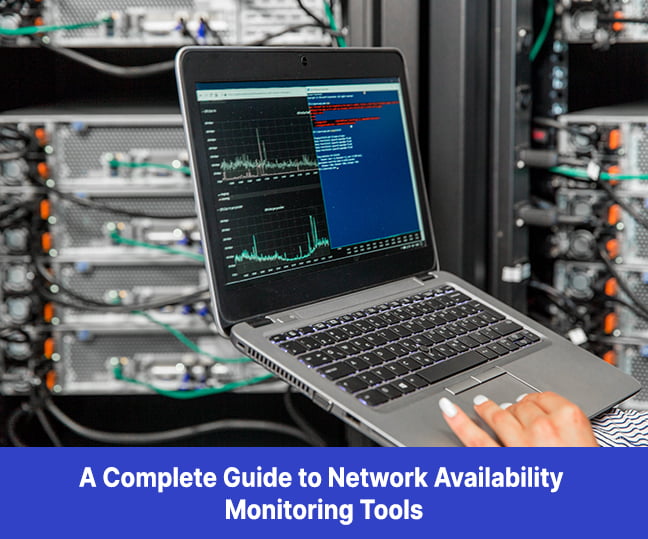When you think about improving visibility into your IT environment, monitoring applications and the other infrastructure that hosts them might be the first thing that comes to mind. Although infrastructure and application monitoring are two essential components of an overall monitoring strategy, network monitoring, and network performance are equally vital—and often easier to overlook. If your network fails or underperforms, your applications will also experience problems.
Furthermore, the need for continuous monitoring due to the rise in network complexities and security concerns is expected to fuel the growth of the network monitoring market. According to MarketsandMarkets, the network monitoring market is expected to grow at a CAGR of 6.9 % from 2022 to 2027. Therefore, it is essential to monitor your network’s performance and availability as closely as you monitor other aspects of your IT resources.
Related article: Types of Network Performance
But how do you gain complete visibility into your multi-vendor network infrastructure? And how do you ensure that all your networks and systems maintain a high level of uptime? To that end, network performance monitoring solutions allow businesses to continuously observe their network for performance problems and take steps to fix them. With the right network performance monitoring solution, you can track your devices’ health and availability while optimizing your network performance and eliminating downtime.
What is Network Performance Monitoring?
Network performance monitoring is a process of measuring and monitoring the quality of service of a network to understand if it is properly operating. It aids network administrators and analysts in gathering network data, allowing them to measure performance variables and identify potential issues or risks. It is an important general IT process that allows administrators to optimize a network’s performance — especially in organizations with strict reliability requirements and in network architectures that are complex.
Why is Network Performance Management (NPM) Important?
The necessity for efficient network performance management is more critical than ever as networks develop and grow more complicated. Effective network performance leads to improved user satisfaction, whether that be internal staff productivity, or customer-facing network components like an e-commerce website, making the business rationale for performance monitoring and testing self-evident. Network monitoring software also makes it feasible to operate without a physical system administrator and perform manual checks. This will save your company both time and money. The reports that are generated as a result of network monitoring are another important benefit. These reports can help you identify system performance patterns and trends and whether upgrades or replacements are required.
Even small or enterprise-level businesses might suffer considerable productivity losses due to a network outage. Using network monitoring tools, you may anticipate potential outages and take proactive steps to resolve network problems. This helps keep the network at your company functional and free of congestion. Furthermore, network monitoring tools can assist you in identifying precisely which areas of your network are experiencing problems. This implies that you may locate the issue with relatively little difficulty, saving you time and money while attempting to solve it.
Here are several other reasons why monitoring your networks is so important:
- To improve network performance and availability
- Stay informed
- Diagnose issues
- Report issues
- Eliminate the need for manual checks
- Proactive approach
- Track trends
- Benchmark performance and availability data
What are the Elements of Network Performance Management (NPM)?

A crucial element of network performance management, which tries to solve performance-related issues, is the establishment of policies, procedures, and network activities. However, the following network performance management techniques can help IT operations run more smoothly while minimizing the likelihood or impact of performance issues.
Collect Good Data
Effective network performance management starts with having the right performance metrics to review. A complex network generates various data, and it can be difficult to sort through that data to find pertinent performance hints.
Network monitoring tools streamline the process by analyzing packet loss, network traffic analysis, network node outages, SNMP performance, or bandwidth usage. The pertinent data is then forwarded to your team for evaluation or is processed by machine learning, artificial intelligence, or AIOps.
Identify Your Metrics
As there are many distinct parts go into keeping your network up and running, network monitoring can produce a wide range of performance metrics that reveal the state of your IT stack. It is possible to become more aware of performance issues in regions of your multi-layered network by identifying the metrics that provide you with the complete picture of it. Your IT team may develop a set of network management policies using that information to reduce problems, boost output, and enhance user experience.
Automated Data Collection
Sometimes it takes a while to identify a pattern of performance issues. An effective network monitoring tool records any performance issues together with essential information like the events around their occurrence. By reviewing a log of earlier issues, your team can spot potential issues that require further in-depth investigation or closer monitoring.
Recognizing Security Issues
Poor network performance is frequently brought on by malware, which may quickly convert your network and your entire company into disasters. A security breach can be costly, time-consuming, and hurt one’s reputation. Install a network monitoring system that can identify malware, unprotected network devices, and other network weaknesses so that your team can develop methods to stop and manage weak points before end users or sensitive data is affected.
How Does Network Performance Monitoring Work?
NPM, or network performance monitoring, gathers information on network traffic as it runs throughout your IT infrastructure. The information may include fundamental network performance indicators like bandwidth and throughput and more intricate details like the routes packets take as they move between endpoints. Additionally, by examining how traffic patterns or metrics differ across various subnets, VPNs, cloud regions, and other network segments that exist inside your IT architecture, network performance monitoring may enable you to interpret monitoring data.
By keeping track of all this data, network performance monitoring enables teams to identify and look into networking problems that can make apps inaccessible or slow to respond. Furthermore, network monitoring is essential since it enables engineers to determine whether a performance issue is caused by an application, host architecture, or the network itself. During network performance monitoring, information from many sources is gathered. It functions by monitoring flow data, SNMP, and packet capture.
Flow Data
The network device produces flow data. These data should include which devices are communicating, for how long, and how often. This should also demonstrate how much data is being sent.
SNMP
The function of network devices is monitored and managed through the popular Simple Network Management Protocol (SNMP). Many network and endpoint devices, like printers and routers, support SNMP. Using SNMP, network status or change may be continuously tracked in real-time.
Packet Capture
Packet capture enables a variety of network monitoring tasks, including network health monitoring, application network performance monitoring, security monitoring, incident response monitoring, service issue debugging, and network capacity planning. This will capture a packet as it travels through a specific network point. Once a packet has been copied, it will be saved so that it can be inspected.
Conclusion
Whether you are running a fully cloud-hosted environment, on-premise servers, or a hybrid solution, not knowing the state of your network puts you in a blind spot where frequent connectivity issues, network outages, and downtime are unavoidable. Without visibility into each aspect of network communication, it can be challenging to determine the source of an issue that needs troubleshooting. But, having the right approach to network monitoring and management gives you comprehensive visibility into your network.
Although network performance monitoring poses some unique challenges, especially in modern, cloud-centric environments, several monitoring approaches and metrics are available for tracking what happens within your networks. Therefore, network administrators should think about implementing the right network monitoring solution to maintain a high-performance and secure network with reduced downtime.

Related article: Top 3 Network Performance
FAQs
What does NPM stand for in networking?
NPM stand for Network Performance Monitoring. It identifies the many mechanisms that preserve the optimum performance levels of a networking infrastructure. This entails the duties of keeping track of, troubleshooting, and evaluating a network’s performance to avoid bottlenecks.
Why is NPM used?
You can use NPM to locate a problem and, in some cases, to show that the network is not at fault. Additionally, it can help you identify problems and resolving them before they have an impact on users.


















